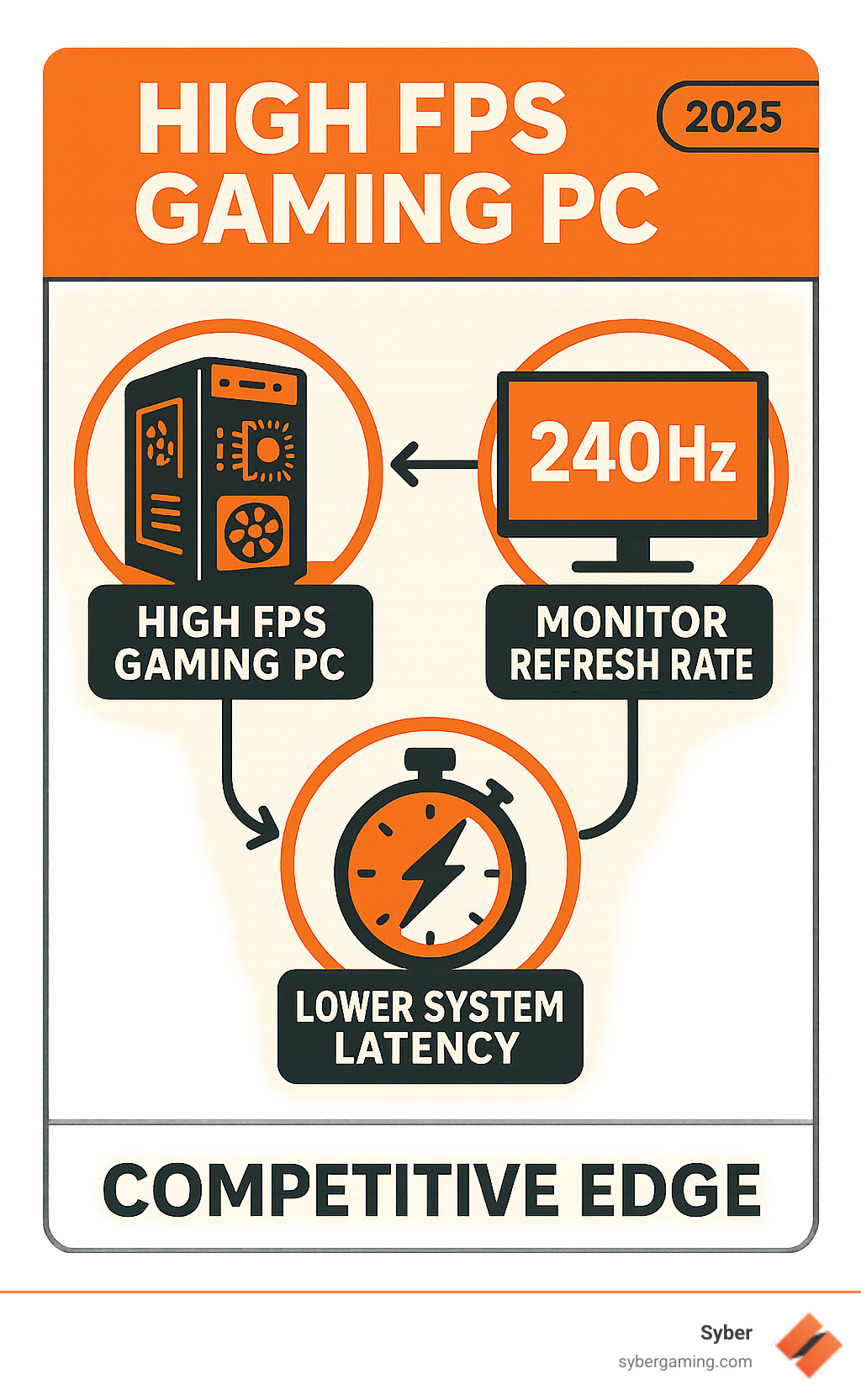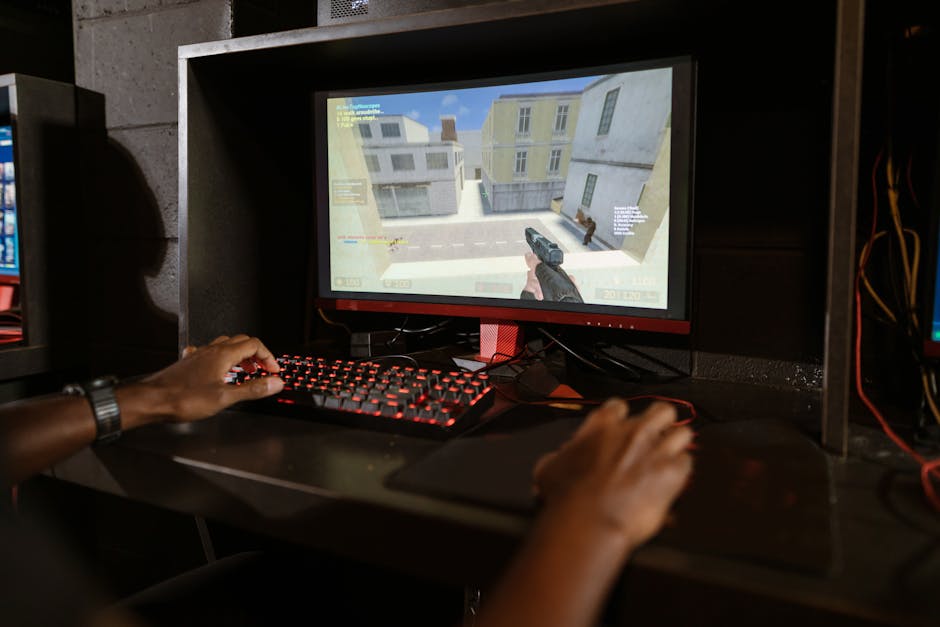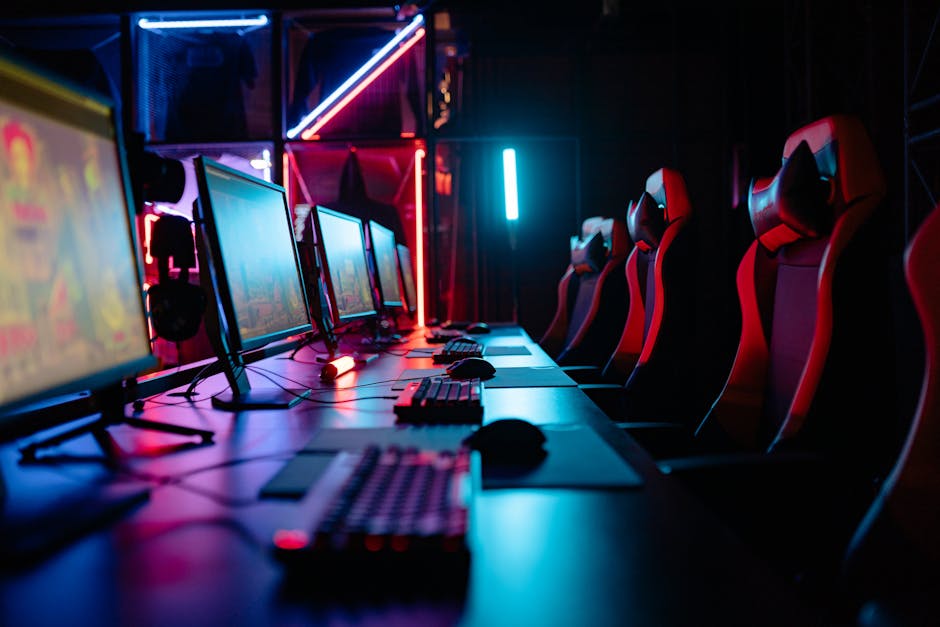What Makes a Gaming PC "High FPS"?
A high fps gaming pc is a system specifically engineered to achieve and maintain high frame rates, typically 144 frames per second (FPS) or more. In competitive games like Counter-Strike 2, VALORANT, or Warzone, a higher frame rate provides a measurable advantage. It's not just about making the game look smoother; it's about reducing the time between your physical action (like clicking the mouse) and the corresponding action appearing on screen. This delay is known as system latency, and minimizing it is the primary goal of a high FPS build. When every millisecond counts, seeing an opponent a fraction of a second earlier can be the difference between winning and losing a duel. The core philosophy is simple: more frames give your brain more visual information, allowing for faster reaction times and more precise aiming.
To achieve this level of performance, a PC must have a carefully selected set of components working in harmony. The target is to consistently produce more frames than the refresh rate of your monitor (e.g., 144 FPS for a 144Hz monitor), ensuring a fluid and responsive experience.
The Core Components of a High FPS Machine
At the center of any high-performance gaming PC are four critical components: the CPU, the GPU, the RAM, and the storage drive. Each plays a distinct and vital role in delivering a high-FPS experience.
Central Processing Unit (CPU): The CPU, or processor, is the brain of the operation. It handles game logic, physics calculations, AI behavior, and prepares all the data for the graphics card to render. For high FPS gaming, single-core performance and high clock speeds are crucial, as many game engines rely heavily on a few fast cores. Modern CPUs like the Intel Core i7/i9 series or AMD's Ryzen 7/9 processors provide the necessary power. Specialized CPUs, such as the AMD Ryzen 7 7800X3D with its large 3D V-Cache, excel in gaming by giving the processor faster access to game data, which significantly boosts frame rates in many titles.
Graphics Processing Unit (GPU): The GPU, or graphics card, is the component that renders the images you see on screen. It takes the data prepared by the CPU and turns it into the final frames. For high FPS, a powerful GPU is non-negotiable. Cards like the NVIDIA GeForce RTX 4070 and above are designed for this purpose. Key factors in a GPU's performance include its architecture, the number of processing cores, and the amount of video memory (VRAM). More VRAM is needed for higher resolutions and detailed textures, but for pure FPS at 1080p or 1440p, the raw processing power of the GPU core is paramount.
Random Access Memory (RAM): RAM acts as short-term memory for your PC, holding data that the CPU needs to access quickly. For gaming, having enough RAM capacity (16GB is the modern baseline, with 32GB recommended for high-end builds and multitasking) prevents performance hitches and stutters. Equally important is RAM speed, measured in megahertz (MHz). Faster RAM, such as DDR5 running at 5600MHz or higher, allows the CPU to feed data to the GPU more quickly, leading to higher and more stable frame rates.
Storage (NVMe SSD): The speed of your storage drive affects how quickly your operating system boots, your games load, and new levels or areas are streamed in. A Non-Volatile Memory Express (NVMe) Solid-State Drive (SSD) is the standard for high FPS gaming. These drives offer significantly faster read/write speeds than older SATA SSDs and traditional hard disk drives (HDDs), reducing loading screens to mere seconds and eliminating in-game stutter caused by slow asset loading in large open-world games.

Finding the Right Balance for Your Games
Building a high FPS PC is an exercise in balance. The CPU and GPU must be well-matched to avoid a "bottleneck," where one component's limited performance holds back the full potential of the other. For example, pairing a top-of-the-line GPU with an entry-level CPU will result in the CPU being unable to prepare frames fast enough, leaving the powerful GPU waiting and underused.
Gamers often face a choice between visual fidelity and raw performance. For competitive play, performance almost always wins. Players in titles like Fortnite or VALORANT frequently lower in-game graphical settings—such as shadows, anti-aliasing, and ambient occlusion—to maximize their frame rate. The most common resolution for competitive gaming is 1080p, as it is less demanding on the GPU and allows for the highest possible FPS. This prioritizes the functional benefits of responsiveness and clarity over cinematic visuals, enabling quicker target acquisition and more precise tracking. For more guidance on selecting components, you can explore our post on What to Consider When Buying a Gaming PC.
Crafting Your High Performance Gaming PC Build
Assembling a high performance gaming pc build requires careful planning, whether you are selecting each part for a custom project or configuring a prebuilt system. The objective remains the same: to create a balanced and optimized machine that delivers maximum, sustained FPS. While building your own PC can be a rewarding experience, choosing a pre built gaming pc customizable from a reputable builder like Syber offers distinct advantages in performance and reliability.

A high performance custom prebuilt gaming pc arrives professionally assembled, with clean cable management and optimized air-flow cooling designed to prevent thermal throttling during long gaming sessions. This approach eliminates the guesswork of component compatibility and the challenges of troubleshooting, providing a system that is stress-tested and ready for top-tier competition right out of the box. It combines the personalization of a custom build with the peace of mind of expert construction and a comprehensive warranty.
The Power Duo and AI-Improved Gaming Performance
As discussed, the CPU and GPU are the engine of any high performance desktop pc. A powerful CPU, like an Intel Core i9 or AMD Ryzen 7 7800X3D, processes game data at incredible speeds, feeding a constant stream of information to a top-tier GPU, such as an NVIDIA GeForce RTX 40-Series card. When these components are correctly balanced, they produce consistently high frame rates across a wide range of titles, from demanding shooters to expansive RPGs. The table below shows estimated performance for popular esports titles with well-balanced hardware configurations.
| Game Title | CPU | GPU | Estimated FPS (1080p, Competitive Settings) |
|---|---|---|---|
| Fortnite | AMD Ryzen 7 9700X | RTX 4060 Ti | Up to 400 FPS |
| Fortnite | Intel Core i5-14400F | RTX 4060 | Up to 300 FPS |
| League of Legends | Ryzen 5 7600X | RTX 4060 Ti | 360+ FPS |
| Valorant | Intel Core i7-14700KF | RTX 4070 Super | 360+ FPS |
| Counter-Strike 2 | Intel Core i7-14700KF | RTX 4070 Ti Super | ~170 FPS |
| Apex Legends | Ryzen 7 7800X3D | RTX 4080 | 240+ FPS |
Modern gaming PCs leverage artificial intelligence to push performance even further. These AI gaming PC features provide significant FPS gains and reduce system latency.
AI-Powered Graphics (Upscaling): Technologies like NVIDIA DLSS (Deep Learning Super Sampling) and AMD FSR (FidelityFX Super Resolution) use AI to boost performance. They work by rendering the game at a lower internal resolution and then using a sophisticated AI algorithm to upscale the image to your monitor's native resolution. The result is a massive increase in FPS with very little, and often imperceptible, loss in visual quality. This allows gamers to enjoy higher frame rates or play at higher resolutions without needing a more powerful GPU.
Latency Reduction: NVIDIA Reflex is another critical AI-driven technology. It synchronizes the CPU and GPU to minimize the render queue, which directly reduces system latency. This makes the game feel more responsive, as the time between your mouse click and the on-screen action is shortened.
AI System Optimization: Syber systems can incorporate AI system optimization profiles that intelligently manage system resources. This software monitors component temperatures, power draw, and workloads in real-time to adjust clock speeds and fan curves automatically. This ensures your PC delivers peak AI-driven performance during intense gameplay while remaining quiet and cool during less demanding tasks.
Essential Peripherals for Your AI-Ready Gaming Setup
A high-performance PC is only one part of the equation. To experience the full benefit of high frame rates, your peripherals must be able to keep up. A complete AI-ready gaming PC setup includes a monitor and input devices designed for competitive play.
High-Refresh-Rate Monitor: A standard 60Hz monitor can only display 60 frames per second. If your PC is producing 200 FPS, you are only seeing a fraction of them. A 144Hz or 240Hz monitor is essential to visualize the extra frames your GPU is rendering. This results in smoother motion, reduced blurring, and the ability to see and react to targets more quickly. Technologies like NVIDIA G-Sync and AMD FreeSync also synchronize the monitor's refresh rate with the GPU's frame output to eliminate screen tearing.
Precision Mouse and Keyboard: A gaming mouse with a high polling rate (1000Hz or more) reports its position to the PC more frequently, resulting in smoother and more accurate cursor movement. A mechanical keyboard offers faster actuation and a more consistent feel than a standard membrane keyboard, ensuring your inputs are registered as quickly as possible. For example, the Syber M1 Gaming Mouse is designed with these competitive needs in mind.
Conclusion: Your Gateway to Competitive Gaming
Investing in a gaming pc high performance build or choosing a professionally assembled pc pre built for gaming is a direct investment in your competitive potential. A well-optimized system provides a tangible advantage in games where split-second reactions determine the outcome. By focusing on a balanced combination of a powerful CPU and GPU, fast RAM, and an NVMe SSD, you create a foundation for high, stable frame rates.
Modern advancements like AI-improved visuals from DLSS and FSR allow you to achieve these performance targets without compromising on resolution, while AI-driven performance technologies like NVIDIA Reflex reduce system latency for a more responsive feel. These features, once reserved for professional-grade hardware, are now accessible in today's gaming PCs.
To fully open up this potential, remember to pair your PC with a high-refresh-rate monitor and precision peripherals. The benefits you will notice immediately include:
- A clear competitive edge from higher and more consistent FPS.
- Exceptionally smooth, tear-free motion on a 144Hz or 240Hz monitor.
- A capable system with AI PC components ready for current and future titles.
Syber’s pre built gaming computers are professionally assembled, rigorously tested, and configured with the latest AI gaming technology. This allows you to bypass the complexities of building and focus on what matters most: performing your best in-game from the moment you power on.
Ready to experience the difference that high FPS and low latency can make? Configure your ideal gaming PC at Syber Gaming.
Find a high performance gaming PC build or a customizable prebuilt rig from Syber. Our systems use advanced AI system optimization and powerful components to deliver smoother frames and lower latency for a competitive edge. Configure yours at https://www.sybergaming.com/






.svg)

